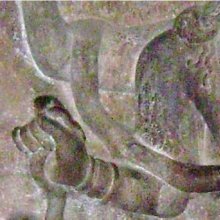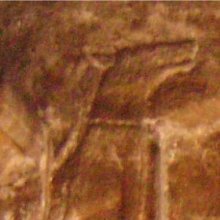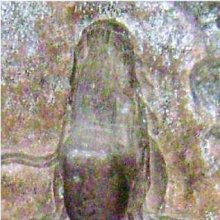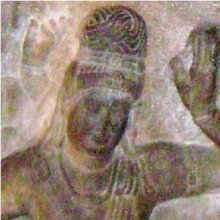Gangadhara, Gaṅgādhāra, Gaṅgādhara, Ganga-dhara, Gamgadhara: 13 definitions
Introduction:
Gangadhara means something in Hinduism, Sanskrit, Jainism, Prakrit, Buddhism, Pali. If you want to know the exact meaning, history, etymology or English translation of this term then check out the descriptions on this page. Add your comment or reference to a book if you want to contribute to this summary article.
Images (photo gallery)
(+3 more images available)
In Hinduism
Shaivism (Shaiva philosophy)
Source: Wisdom Library: ŚaivismGaṅgādhara (गङ्गाधर) is the Sanskrit name of a deity presiding over Himasthāna, one of the sixty-eight places hosting a svāyambhuvaliṅga, which is one of the most sacred of liṅgas according to the Śaivāgamas. The list of sixty-eight svāyambhuvaliṅgas and presiding deities (e.g., Gaṅgādhara) is found in the commentary on the Jirṇoddhāra-daśaka by Nigamajñānadeva. The word liṅga refers to a symbol used in the worship of Śiva and is used thoughout Śaiva literature, such as the sacred Āgamas.

Shaiva (शैव, śaiva) or Shaivism (śaivism) represents a tradition of Hinduism worshiping Shiva as the supreme being. Closely related to Shaktism, Shaiva literature includes a range of scriptures, including Tantras, while the root of this tradition may be traced back to the ancient Vedas.
Vyakarana (Sanskrit grammar)
Source: Wikisource: A dictionary of Sanskrit grammarGaṅgādhara (गङ्गाधर).—[GANGADHARA SHASTRI TELANG] (l) a stalwart grammarian and Sanskrit scholar of repute who was a pupil of Bālasarasvatī of Vārāṇaśī and prepared in the last century a host of Sanskrit scholars in Banaras among whom a special mention could be made of Dr. Thebaut, Dr. Venis and Dr. Gaṅgānātha Jhā. He was given by Government of India the titles Mahāmahopādhyāya and C. I.E. His surname was Mānavallī but he was often known as गङाधरशास्त्री तेलङ्ग (gaṅādharaśāstrī telaṅga). For details, see Mahābhāṣya, D.E. Society Ed.Poona p.p.33, 34; (2)an old scholar of Vyākarana who is believed to have written a commentary on Vikṛtavallī of Vyādi; (3) a comparatively modern scholar who is said to have written a commentary named Induprakāśa on the Śabdenduśekhara; (4) author of the Vyākaraṇadīpaprabhā, a short commentary on the Vyākaraṇa work of Cidrūpāśramin. See चिद्रूपाश्रमिन् (cidrūpāśramin).

Vyakarana (व्याकरण, vyākaraṇa) refers to Sanskrit grammar and represents one of the six additional sciences (vedanga) to be studied along with the Vedas. Vyakarana concerns itself with the rules of Sanskrit grammar and linguistic analysis in order to establish the correct context of words and sentences.
Shilpashastra (iconography)
Source: Shodhganga: Iconographical representations of Śiva (shilpa)1) Gaṅgādhara (गङ्गाधर) or Gaṅgādharamūrti refers to one of the eighteen forms (mūrti) of Śiva mentioned in the Kāraṇāgama (pratimālakṣaṇavidhi-paṭala): the fourth among the Siddhāntaśaivāgamas. The forms of Śiva (e.g., Gaṅgādhara) are established through a process known as Sādākhya, described as a five-fold process of creation.
2) Gaṅgādhara is also listed among the eighteen forms (mūrti) of Śiva mentioned in the Śilparatna (twenty-second adhyāya): a technical treatise by Śrīkumāra on Śilpaśāstra.

Shilpashastra (शिल्पशास्त्र, śilpaśāstra) represents the ancient Indian science (shastra) of creative arts (shilpa) such as sculpture, iconography and painting. Closely related to Vastushastra (architecture), they often share the same literature.
In Jainism
General definition (in Jainism)
Source: archive.org: TrisastisalakapurusacaritraGaṅgādhara (गङ्गाधर) refers to one of the two sons of the maternal uncle of Jayacandrā (is the daughter of Śrīkāntā and Vidyādhara-king Indradhanus from Sūrodaya), according to chapter 6.8 [śrī-mahāpadma-cakrin-caritra] of Hemacandra’s 11th century Triṣaṣṭiśalākāpuruṣacaritra: an ancient Sanskrit epic poem narrating the history and legends of sixty-three illustrious persons in Jainism.
Accordingly:—“[...] Two sons of Jayacandrā’s maternal uncle, Gaṅgādhara and Mahīdhara, possessing great vidyās, insolent from pride in their vidyās and from pride in their arms, heard of her marriage and at once became very angry. For the desire for one object is the cause of great hostility. The heroes came together to Sūrodaya with all their army to fight Jayacandrā’s husband. Padma, with a retinue of Vidyādharas, his strength of arm irresistible, left the city, eager for battle without trickery. [...]”.

Jainism is an Indian religion of Dharma whose doctrine revolves around harmlessness (ahimsa) towards every living being. The two major branches (Digambara and Svetambara) of Jainism stimulate self-control (or, shramana, ‘self-reliance’) and spiritual development through a path of peace for the soul to progess to the ultimate goal.
Languages of India and abroad
Pali-English dictionary
Source: BuddhaSasana: Concise Pali-English Dictionarygaṅgādhāra : (m.) a river-basin.

Pali is the language of the Tipiṭaka, which is the sacred canon of Theravāda Buddhism and contains much of the Buddha’s speech. Closeley related to Sanskrit, both languages are used interchangeably between religions.
Sanskrit dictionary
Source: DDSA: The practical Sanskrit-English dictionaryGaṅgādhara (गङ्गाधर).—
1) an epithet of Śiva.
2) the ocean. °पुरम् (puram) Name of a town.
Derivable forms: gaṅgādharaḥ (गङ्गाधरः).
Gaṅgādhara is a Sanskrit compound consisting of the terms gaṅgā and dhara (धर).
Source: Cologne Digital Sanskrit Dictionaries: Shabda-Sagara Sanskrit-English DictionaryGaṅgādhara (गङ्गाधर).—m.
(-raḥ) 1. An epithet of Siva. 2. The ocean. E. gaṅgā the Ganges, and dhara who possesses or receives; according to the legend, the Ganges in its descent first alighted on the head of Siva, and continued for some period entangled in his hair.
Source: Cologne Digital Sanskrit Dictionaries: Aufrecht Catalogus Catalogorum1) Gaṅgādhara (गङ्गाधर) as mentioned in Aufrecht’s Catalogus Catalogorum:—one of the teachers of Nīlakaṇṭha (Mahābhārataṭīkā). Oxf. 1^b.
2) Gaṅgādhara (गङ्गाधर):—father of Śyāmasundara (Devapratiṣṭhāprayoga). Sb. 137.
3) Gaṅgādhara (गङ्गाधर):—poet. [Sūktikarṇāmṛta by Śrīdharadāsa] [Subhāshitāvali by Vallabhadeva]
4) Gaṅgādhara (गङ्गाधर):—a poet at the court of Karṇa of Ḍāhala was vainquished by Bilhaṇa. Vikramāṅkacarita 18, 95.
5) Gaṅgādhara (गङ्गाधर):—lexicographer. Quoted by Gadasiṃha and Rāmanātha. See Gaṅgādharakośa.
6) Gaṅgādhara (गङ्गाधर):—a medical writer. Oudh. X, 24.
7) Gaṅgādhara (गङ्गाधर):—Ācāratilaka. H. 183.
8) Gaṅgādhara (गङ्गाधर):—Ādhānapaddhati. Bhr. 524. Gṛhyāgnyādhānapaddhati. Bp. 299. Kātyāyanasūtraṭīkā. B. 1, 164. Kātyāyanaśulbasūtrabhāṣya. Peters. 2, 173. Pākayajñapaddhati. Ben. 14. Bp. 299. Prayogapaddhati Baudh. B. 1, 132. Ben. 6. Np. Ii, 4. Bhr. 103. Peters. 2, 172. Smārtapadārthasaṃgrahapaddhati. Bp. 301.
9) Gaṅgādhara (गङ्गाधर):—Ānandalaharīṭīkā. K. 204.
10) Gaṅgādhara (गङ्गाधर):—Āhnika. Oudh. Xii, 26. Kāṭhakāhnika. Oudh. Xvi, 80.
11) Gaṅgādhara (गङ्गाधर):—Induprakāśa Śabdenduśekharaṭīkā. K. 78.
12) Gaṅgādhara (गङ्गाधर):—Uṇādivṛtti. Zmg. 1868, 322.
13) Gaṅgādhara (गङ्गाधर):—Kāyasthotpatti. Oudh. Iii, 16. Cāturvarṇyavivaraṇa. Oudh. Iii, 16.
14) Gaṅgādhara (गङ्गाधर):—Candramānatantra jy. Ben. 29.
15) Gaṅgādhara (गङ्गाधर):—author of Chandomañjarī. See Gaṅgādāsa.
16) Gaṅgādhara (गङ्गाधर):—Tarkadīpikāṭīkā. Rice. 108:
17) Gaṅgādhara (गङ्गाधर):—(rather Gadādhara): Tarkavāda. Oppert. 3983. 4302. 7977.
18) Gaṅgādhara (गङ्गाधर):—Tithinirṇaya. NW. 108. Dāyabhāgaṭīkā. NW. 108. Sarvaliṅgasaṃnyāsanirṇaya. NW. 108.
19) Gaṅgādhara (गङ्गाधर):—Devatārcanavidhi. Burnell. 146^a.
20) Gaṅgādhara (गङ्गाधर):—Nirṇayamañjarī. B. 3, 98.
21) Gaṅgādhara (गङ्गाधर):—Nyāyakutūhala. B. 4, 22.
22) Gaṅgādhara (गङ्गाधर):—Nyāyacandrikā. Oppert. Ii, 518. 1247. 4584.
23) Gaṅgādhara (गङ्गाधर):—Paribhāṣāḥ [grammatical] in verse. Oudh. Xix, 54. Vṛttadarpaṇa, metrics. Oudh. Xix, 58. Śabdapāṭha, on declension. Oudh. Xix, 54.
24) Gaṅgādhara (गङ्गाधर):—Pratiṣṭhācintāmaṇi. K. 184. Pratiṣṭhānirṇaya. L. 2765.
25) Gaṅgādhara (गङ्गाधर):—Badarikāmāhātmyasaṃgraha. NW. 502.
26) Gaṅgādhara (गङ्गाधर):—Bhāsvatīṭīkā jy. Oudh. Xiv, 48. Bp. 273.
27) Gaṅgādhara (गङ्गाधर):—Yogaratnāvalī. Io. 2357.
28) Gaṅgādhara (गङ्गाधर):—Rasapadmākara alaṃk. Lahore. 8.
29) Gaṅgādhara (गङ्गाधर):—Vasumatīcitrāsana kāvya. Oppert. 4714.
30) Gaṅgādhara (गङ्गाधर):—Vidhiratna [dharma] Oppert. 4716.
31) Gaṅgādhara (गङ्गाधर):—Viśveśvarastutipārijāta. Oudh. Viii, 28.
32) Gaṅgādhara (गङ्गाधर):—Vedāntaśrutisārasaṃgraha. Oudh. V, 24.
33) Gaṅgādhara (गङ्गाधर):—Vyākaraṇadīpaprabhā, a
—[commentary] on Cidrūpāśrama’s Vyākaraṇadīpa. Burnell. 41^a.
34) Gaṅgādhara (गङ्गाधर):—Śākunikapraśna, augury. Sūcīpattra. 20.
35) Gaṅgādhara (गङ्गाधर):—Ṣoḍaśakarmapaddhati. Bik. 462.
36) Gaṅgādhara (गङ्गाधर):—Saṃskārabhāskara. K. 200. ‘By a son of Gaṅgādhara’. Sb. 63.
37) Gaṅgādhara (गङ्गाधर):—Saṃgītasetu Saṃgītaratnākaraṭīkā. Burnell. 59^b.
38) Gaṅgādhara (गङ्गाधर):—Sāmagrīvāda [nyāya] Oppert. 5703.
39) Gaṅgādhara (गङ्गाधर):—
—[commentary] on the Sūryaśataka. Hall. Vāsavadattā p. 7.
40) Gaṅgādhara (गङ्गाधर):—Smārtapadārthasaṃgraha. Ben. 5.
41) Gaṅgādhara (गङ्गाधर):—Smṛticintāmaṇi. Io. 169. NW. 84.
42) Gaṅgādhara (गङ्गाधर):—called also lakṣmīdhara younger brother of Viṣṇu, son of Govardhana, grandson of Divākara, of Jambūsaronagara: Gaṇitāmṛtasāgarī or Aṅkāmṛtasagarī Līlāvatīṭīka. Grahalāghavavivṛti. B. 4, 128. Tājikaratna. K. 230. Pañcapakṣīprakāśa. NW. 520. Pāṭīlīlāvatīviveka. B. 4, 154. Pārāśarapaddhati jy. B. 4, 156. Varṣaphalatantra. Peters. 2, 194.
43) Gaṅgādhara (गङ्गाधर):—son of Bhairava Daivajña: Praśnabhairava. NW. 538. 556. Oudh. Iii, 14. Muhūrtabhairava. Bik. 315.
44) Gaṅgādhara (गङ्गाधर):—son of Rāmacandra, and brother of Yājñika Nārāyaṇa: Prakṛtivikṛtiyāgakālaviveka. Ben. 14. Peters. 2, 173. Pravāsakṛtya, composed at Stambatīrtha in 1606. L. 701. Sarvatomukhapaddhati. Ben. 15.
45) Gaṅgādhara (गङ्गाधर):—son of Śivaprasāda: Setusaṃgraha, a
—[commentary] on Vopadeva's Mugdhabodha. L. 1540.
46) Gaṅgādhara (गङ्गाधर):—son of Sadāśiva, grandson of Vīreśvara Mahāḍakara, pupil of Advaitānanda Yati: Ārāmādipratiṣṭhāpaddhati. Hall. p. 94. Gaṅgāstotra. Hall. p. 94. Tarkacandrikā. Tirthakāśikā. Hall. p. 94. Taittirīyakasārārthacandrikā. Hall. p. 94. Dhyānavallarī. L. 1243. K. 122. Nāmakaumudī. L. 2110. Nārāyaṇatattvavāda. Hall. p. 94. Prapañcasāraviveka. K. 186. Poona. 165. Bhāvasāraviveka. Hall. p. 94. Maṇikarṇikāstotra. Printed in Ha7berlin p. 475. Mantravallarī Mantramahodadhiṭīkā. L. 2776. Rāmastuti. Hall. p. 94. Viṣṇusahasranāman, composed in 1762. K. 206. Śārīrakasūtrasārārthacandrikā or Subodhinī. Io. 600. Hall. p. 94. K. 136. Sb. 416.
47) Gaṅgādhara (गङ्गाधर):—Prayogapaddhati. read B. 1, 232.
48) Gaṅgādhara (गङ्गाधर):—Viśveśvarastutipārijāta. read [Oudh 1876-1877], 28.
49) Gaṅgādhara (गङ्गाधर):—Saṃgītasetu. This is in Hindi.
50) Gaṅgādhara (गङ्गाधर):—Smṛticintāmaṇi. He was a son of Gopīnātha.
51) Gaṅgādhara (गङ्गाधर):—son of Govardhana: read Varṣaphalapaddhati instead of Varṣaphalatantra
52) Gaṅgādhara (गङ्गाधर):—son of Rāma: Saṃskārapaddhati. read Bp. 301.
53) Gaṅgādhara (गङ्गाधर):—son of Sadāśiva: Maṇikarṇikāstotra. read p. 471.
54) Gaṅgādhara (गङ्गाधर):—See Kākoji.
55) Gaṅgādhara (गङ्गाधर):—father of Dāmodara (Yantracintāmaṇi).
56) Gaṅgādhara (गङ्गाधर):—father of Lakṣmaṇa Kavi (Yuddhakāṇḍa in Campūrāmāyaṇa).
57) Gaṅgādhara (गङ्गाधर):—brother of Mahīdhara, son of Manoratha, son of Cakrapāṇi, son of Dāmodara, composed an inscription in 1137/38. He wrote an Advaitaśataka. Epigraphia Indica Ii, 330.
58) Gaṅgādhara (गङ्गाधर):—Grahabhāvaprakāśaṭīkā. Peters. 4, 36. Stein 158 (Gadādhara).
59) Gaṅgādhara (गङ्गाधर):—Candravilāsa nāṭaka.
60) Gaṅgādhara (गङ्गाधर):—Tarkabhāṣāṭīkā.
61) Gaṅgādhara (गङ्गाधर):—Nṛsiṃhacaritasudhā.
62) Gaṅgādhara (गङ्गाधर):—Yogasāra med.
63) Gaṅgādhara (गङ्गाधर):—younger brother of Viṣṇu and Lakṣmīdhara, son of Govardhana: Gaṇitāmṛtasāgarī Līlāvatīṭīkā.
64) Gaṅgādhara (गङ्गाधर):—son of Bhairava Daivajña, grandson of Kṛṣṇa: Muhūrtālaṃkāra, composed in 1632.
65) Gaṅgādhara (गङ्गाधर):—son of Sadāśiva, grandson of Vīreśvara Mahāḍakara: Pañcīkaraṇacandrikā. Prapañcasāraviveka or Bhavasāraviveka.
—Bhāvasāraviveka to be omitted.
66) Gaṅgādhara (गङ्गाधर):—son of Rāmacandra, father of Rāmakṛṣṇa. Gaṅgādhara wrote a bhāṣya on Kātyāyana’s Śulbasūtra, and this was completed by his son Rāmakṛṣṇa. Ulwar Extr. 47.
67) Gaṅgādhara (गङ्गाधर):—son of Vidhicandra, wrote in 1686: Bhāsvatīkaraṇodāharaṇa.
68) Gaṅgādhara (गङ्गाधर):—Laghusaundaryalaharī.
69) Gaṅgādhara (गङ्गाधर):—son of Deveśvara, pupil of Milhaṇa, the author of Cikitsāmṛta.
70) Gaṅgādhara (गङ्गाधर):—son of Bhairava Daivajña: Tājikaratna.
Source: Cologne Digital Sanskrit Dictionaries: Monier-Williams Sanskrit-English Dictionary1) Gaṅgādhara (गङ्गाधर):—[=gaṅgā-dhara] [from gaṅgā > gaṅga] m. ‘Ganges-receiver’, the ocean, [cf. Lexicographers, esp. such as amarasiṃha, halāyudha, hemacandra, etc.]
2) [v.s. ...] ‘Ganges-supporter’, Name of Śiva (according to the legend the Ganges in its descent from heaven first alighted on the head of Śiva and continued for a long period entangled in his hair cf. [Rāmāyaṇa i, [chapter] 44])
3) [v.s. ...] Name of a man
4) [v.s. ...] of a lexicographer
5) [v.s. ...] of a commentator on the Śārīraka-sūtras
6) [v.s. ...] of a commentator on Bhāskara
7) Gaṅgādhāra (गङ्गाधार):—[=gaṅgā-dhāra] [from gaṅgā > gaṅga] m. (= -dhara) the ocean, [Demetrius Galanos’s Lexiko: sanskritikes, anglikes, hellenikes]
Source: Cologne Digital Sanskrit Dictionaries: Yates Sanskrit-English DictionaryGaṅgādhara (गङ्गाधर):—[gaṅgā-dhara] (raḥ) 1. m. Shiva; the ocean.
[Sanskrit to German]
Sanskrit, also spelled संस्कृतम् (saṃskṛtam), is an ancient language of India commonly seen as the grandmother of the Indo-European language family (even English!). Closely allied with Prakrit and Pali, Sanskrit is more exhaustive in both grammar and terms and has the most extensive collection of literature in the world, greatly surpassing its sister-languages Greek and Latin.
Kannada-English dictionary
Source: Alar: Kannada-English corpusGaṃgādhara (ಗಂಗಾಧರ):—
1) [noun] Śiva, who is holding in the mass of his hair, the holy Gaṃgāstream.
2) [noun] ಆಗಭೋಗಕ್ಕೆಲ್ಲಾ ರಂಗಸ್ವಾಮಿ, ಸತ್ಯಪ್ರಮಾಣಕ್ಕೆಲ್ಲಾ ಗಂಗಾಧರ [agabhogakkella ramgasvami, satyapramanakkella gamgadhara] āgabhōgakkellā raṃgasvāmi, satya pramāṇakkelāgaṃgādhara (prov.) while one is designated for labour, the other for enjoyment.
Kannada is a Dravidian language (as opposed to the Indo-European language family) mainly spoken in the southwestern region of India.
See also (Relevant definitions)
Partial matches: Dhara, Ganga.
Starts with (+5): Gangadhara adhvarin, Gangadhara bhatta, Gangadhara cakravartin, Gangadhara daivajna, Gangadhara kavi, Gangadhara mahadakara, Gangadhara pandita, Gangadhara sarasvati, Gangadhara sharman, Gangadhara shastrin, Gangadhara vajapeyin, Gangadhara yati, Gangadharabhatta, Gangadharacurna, Gangadharakavi, Gangadharakosha, Gangadharamadhava, Gangadharamurti, Gangadharanatha, Gangadharapratishtha.
Ends with: Gitagangadhara, Laghugangadhara, Rasagangadhara, Samskaragangadhara, Vaidyagangadhara, Vriddhagangadhara.
Full-text (+227): Tirthakashika, Shabdapatha, Setusamgraha, Vyakaranasamgraha, Samskaragangadhara, Gangadharacurna, Gangadharapura, Gangadharabhatta, Gangadhararasa, Gangadharamadhava, Rasagangadhara, Vaidyagangadhara, Laghugangadhara, Gitagangadhara, Pratapavilasa, Kankataran, Vriddhagangadhara, Shivaprasada, Tajikaratna, Prakritivikritiyagakalaviveka.
Relevant text
Search found 40 books and stories containing Gangadhara, Gaṅgādhāra, Gaṅgādhara, Ganga-dhara, Gamgadhara, Gaṅgā-dhara, Gaṅgā-dhāra, Gaṃgādhara; (plurals include: Gangadharas, Gaṅgādhāras, Gaṅgādharas, dharas, Gamgadharas, dhāras, Gaṃgādharas). You can also click to the full overview containing English textual excerpts. Below are direct links for the most relevant articles:
Sahitya-kaumudi by Baladeva Vidyabhushana (by Gaurapada Dāsa)
Text 10.1 [Upamā] < [Chapter 10 - Ornaments of Meaning]
Text 10.20 < [Chapter 10 - Ornaments of Meaning]
Text 10.178 < [Chapter 10 - Ornaments of Meaning]
Jivanandana of Anandaraya Makhin (Study) (by G. D. Jayalakshmi)
Family of Ānandarāya Makhin < [Chapter 2 - Author, His Life and Works]
The Skanda Purana (by G. V. Tagare)
Chapter 61 - Eminence of Gaṅgādhara Tīrtha < [Section 3 - Arbuda-khaṇḍa]
Chapter 178 - The Greatness of Gaṅgāvākaka Tīrtha < [Section 3 - Revā-khaṇḍa]
Chapter 49 - Eulogy of Rāmanātha < [Section 1 - Setu-māhātmya]
Alamkaras mentioned by Vamana (by Pratim Bhattacharya)
26: Alaṃkāra-śāstra according to Jagannātha (17th Century) < [Chapter 2 - The concept of alaṃkāra in Sanskrit Poetics]
13: Definition of Vibhāvanā Alaṃkāra < [Chapter 4 - Arthālaṃkāras mentioned by Vāmana]
18: Definition of Dīpaka Alaṃkāra < [Chapter 4 - Arthālaṃkāras mentioned by Vāmana]
Who’s Who Among Our Contributors < [January – March, 2000]
Telugu Literature under Kutub Shahis < [April-June 1942]
Who’s Who Among Our Contributors < [October – December, 2000]
Rudra-Shiva concept (Study) (by Maumita Bhattacharjee)
2.40. Śiva as Candracūḍa and Nāgakuṇḍala < [Chapter 6a - The Epithets of Rudra-Śiva]
Related products





